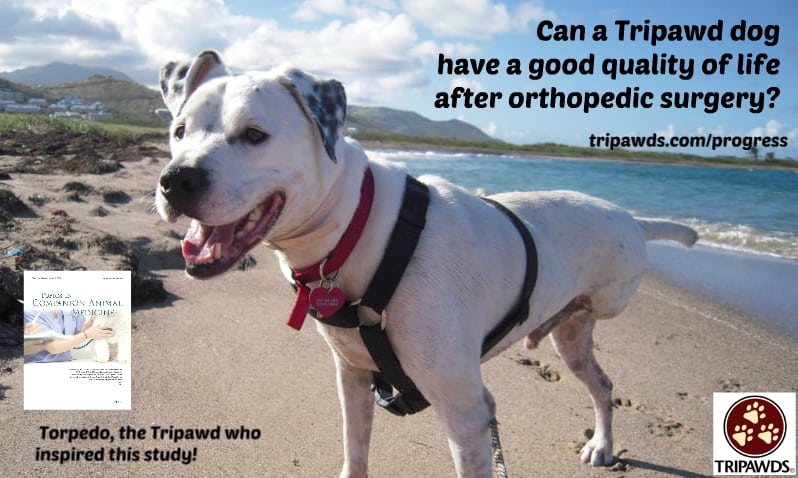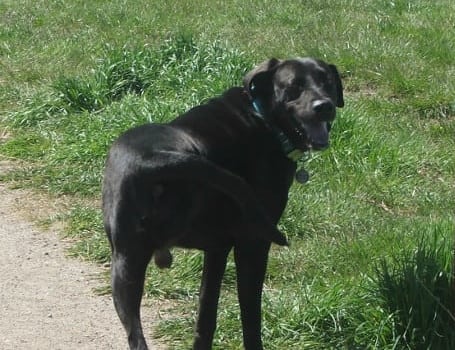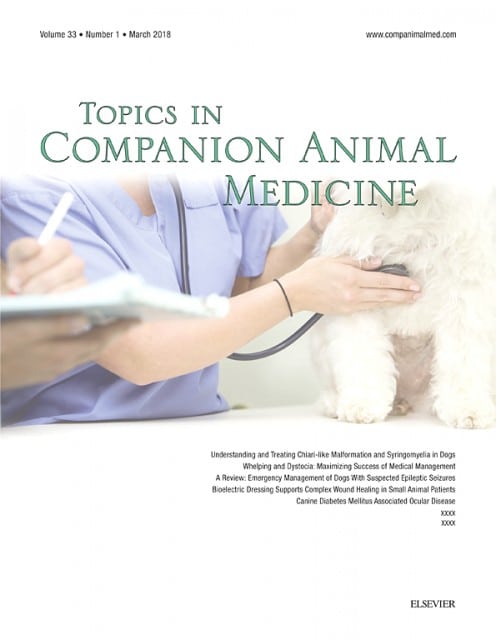Can a Tripawd dog have a good quality of life after an orthopedic surgery on a remaining limb? A scientist from the Colorado State University Veterinary Teaching Hospital wanted to find out. Her multi-year Tripawd research project, “Postamputation Orthopedic Surgery in Canine Amputees,” is now available for all of us to download and read, in the peer-reviewed “Topics in Companion Animal Medicine” journal, Volume 33, Issue 3, September 2018, Pages 89-96.
Download the Postamputation Orthopedic Surgery in Canine Amputees Study Until October 17, 2018

The vast majority of peer-reviewed veterinary studies are only available to paid subscribers, so hurry and get your copy of the Postamputation Orthopedic Surgery in Canine Amputees Study. It will only be live until October 17. You do not need a user account, nor do you need to provide your email. Anyone with this link can download it.
CSU’s Dr. Elena Contreras, DVM MS initiated the study after becoming inspired by her Tripawd Torpedo, who had a TPLO surgery for a torn CCL on his remaining rear limb when he was about 10 years old. He just passed away last year at 15! Her work began in 2013 when Tripawds.com was contacted to help her find amputee dogs who had subsequent orthopedic disease (with a diagnosis) in a remaining limb, which was treated via surgery, orthotics or medical management. From the beginning we were excited to participate. That’s because even though cranial cruciate tears are one of the most common injuries in Tripawd dogs, there is little research about how surgeries like TPLO and FHO affect them.
The objective of this study was to document cases of postamputation orthopedic surgery in canines and evaluate owner satisfaction and outcome. Postamputation Orthopedic Surgery in Canine Amputees Study
The sample is small, but the findings are huge. Thanks to Dr. Contreras, veterinarians now have a solid body of work to reference when presenting Tripawd pet parents with the news that their dog needs an orthopedic surgery on a remaining limb.

Any Tripawd parent being faced with a remaining limb surgery on a Tripawd dog will find this helpful. Now, both veterinarian and owner can review documented evidence to see how well dogs fared in different scenarios. For example.
- Perioperative outcome was acceptable in 15 of the 17 dogs. Two cases had major complications, including asseptic arthritis after TPLO surgery and uncontrolled long-term pain for several months afterward.
- Despite the challenges some faced, all 12 survey respondents were satisfied with the postamputation orthopedic surgeries and outcome.
- These Tripawd parents said they would recommend surgery to other owners of canine amputees with similar orthopedic diseases.
We hope this is the first of many more studies about Tripawd dog and cat health issues.
Future research is needed to determine if there is a relationship between canine amputation and subsequent orthopedic disease, including potential factors, forces, or events such as neurologic, body condition, age, activity level, hormonal, genetic, or comorbidities that might predispose an amputee to develop orthopedic disease. Associations between reason for amputation and PAOD as well as the temporal relationship of the development of PAOD also warrant exploration.
If your three-legged dog is being faced with a remaining leg surgery like Frankie, fear not. You’ll see that even with some post-surgery complications, Tripawds pet parents who have been through the recovery process don’t hesitate to recommend it to others.
 Join the forum discussion on this topic!
Join the forum discussion on this topic!
Thank you, I had another opinion from another orthopedic surgeon ,plus 2 canine rehab center vets, plus his skin and allergy vet and a human orthopedic surgeon. Everyone was in agreement with amputating. He is now post – op day 5. I just figured out how to do the forum page so sorry for the late response. I realized that Drakey’s situation is very rare. I am looking for help in getting him more comfortable at this point. He was not eating until yesterday. He had a great day yesterday.. however this morning he would not eat. He has a fentanyl patch, on gabapentin,carprofen,antibiotics,and I asked for anti-nausea meds (cerania). But his wound looks more swollen and some areas of redness. He keeps jerking back like he is having phantom pain. So I gave him another gabapentin (perscribed dose) and he is now passed out. I guess the fentanyl patch is weaker.. maybe feeling more pain? Hence not wanting to eat?
Michelle, sorry to hear about his issues. A Fentanyl patch would have worn off by now. It’s important to let your vet know what’s going on. Meanwhile please post in our Discussion Forums so we can help you and Drakey better OK? See you there.
Hello I am faced with complications of TPLO Surgery with my 4 year old Goldendoodle . He has had 4 surgeries to save his hind leg and now. 1) TPLO left hind leg 2) remove plates 3)remove pin left in leg after 2nd surgery 4) exploration and biopsy of bone to get rid of the osteomyelitis. so now his patella has displaced and the bones are barely fusing. We are talking about amputation and I wanted to read this article. Im finding very little research regading this matter.
Michelle, sorry to hear about your dog. When in doubt, get another opinion from another orthopedic surgeon in a different practice. Otherwise I’m not sure what specific research you are looking for so please join us in our Discussion Forums so we can help you better. Hope to see you there.